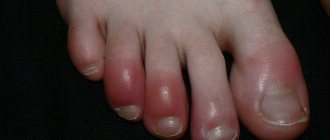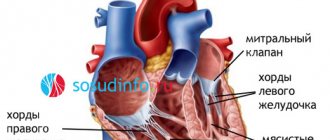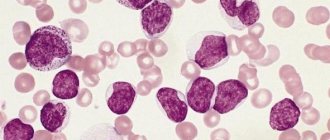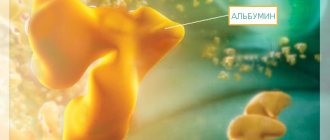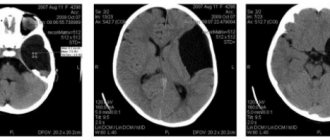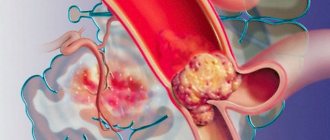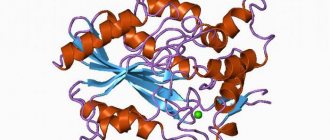Metabolism or exchange of substances occurs constantly in the body. This is not a single process, but rather a group of natural phenomena. They ensure normal life activities.
A special case is the so-called lipid metabolism. In other words, fat. Accumulation and burning. Normally, such processes are balanced. Therefore, a person does not gain excess weight. Special substances play a big role in this matter.
HDL is one such compound, the acronym stands for high-density lipoprotein. Despite the fact that these chemical active substances are smaller in size than others, they play a major antiatherogenic role. That is, they reduce the concentration of cholesterol and allow the body to function normally. The likelihood of atherosclerosis also decreases.
We can say that high-density lipoproteins are welcome guests in the human body. Therefore, you need to strive to increase this “good” cholesterol. The name is not entirely accurate, but reflects the essence of the connection and its function.
What else do patients need to know about high-density lipoproteins? It is necessary to understand the issue in more detail.
The role of the substance in the body
Actually, the functions of HDL themselves can be distinguished into two.
- The first is fat transfer. In fact, these compounds are transporters for cholesterol. Without this substance, there can be no normal life activity, since lipids act as a kind of building material for the body. Thus, HDL ensures the transport of cholesterol throughout the body and normal metabolism.
- The main role of high-density lipoproteins is the utilization of excess fat. The small size and disc-shaped shape make it possible to attach a lot of substance.
HDL particles pick up cholesterol, transport it throughout the body and allow excess to be eliminated naturally.
Due to their special chemical and physical structure, high-density lipoproteins can collect fatty compounds, including from the walls of blood vessels. This prevents the development of plaques and atherosclerosis.
The main function of HDL is its antiatherogenicity.
There are a number of problems that high-density lipoproteins solve indirectly:
- They ensure normal cell regeneration. Due to its ability to tolerate cholesterol.
- Promote restructuring of cytological structures.
Ultimately, by assessing the amount of HDL, it is possible to predict the risks of atherosclerosis, correct them and fight the disease. This is an important clinical function.
Standard tables
The normal level of HDL in the blood ranges from 0.8 to 2.4 mmol/liter of blood in adult women and from 0.7 to 2.1 mmol/liter of blood in men. Detailed data by age is presented in the tables below.
Among women
| Age (years) | Norm HDL in mmol per liter |
| 20-25 | 0.8-2 |
| 26-30 | 0.9-2.1 |
| 30-35 | 0.9-2 |
| 35-40 | 0.75-2.13 |
| 40-50 | 0.8-2.2 |
| Over 50 years old | 0.9-2.4 |
In men
| Age | Amount of HDL in mmol/liter |
| 20-25 | 0.7-1.67 |
| 26-30 | 0.8-1.6 |
| 30-35 | 0.75-1.63 |
| 35-40 | 0.8-2.1 |
| 40-50 | 0.7-1.7 |
| After 50 | 0.7-1.6 |
In children
| Age | Norm HDL (mmol/l) |
| Up to 1 year | 0.8-1.8 |
| 1-5 years | 0.9-1.9 |
| 6-10 years | 0.9-1.91 |
| 10-15 years | 0.95-1.92 |
| 15-20 years | 0.7-1.6 |
Possible minimum deviations from the specified values. Also, normal levels of HDL in the blood depend on adequate values that are accepted in the specific laboratory where the test was taken.
Causes of decreased HDL and treatment methods
A drop in high-density lipoprotein concentration is a bad thing. Because the risks of atherosclerosis increase. It is necessary to increase the volume of this substance in the body as quickly as possible.
Among the reasons for the phenomenon:
Poor nutrition
Perhaps the main factor in the development of the pathological process. With insufficient intake of “good” cholesterol, a decrease in the level of high-density lipoproteins is observed. This is a harmful phenomenon in which the concentration of harmful substances increases.
Eventually, fats are deposited on the walls of blood vessels, forming plaques. Blood flow weakens. Ischemic processes begin.
When the problem is localized in the coronary or cerebral arteries, heart attack and stroke are almost inevitable. It is the matter of time. Therefore, we need to quickly combat this factor. Fortunately, everything is in the hands of the patient himself.
The treatment is simple. It involves adjusting your diet. Eggs and butter contain large amounts of good cholesterol. With moderate consumption of animal fats, HDL concentrations also increase.
It is important to create conditions so that the basis of the diet is food of plant origin. Lean meat like chicken breast is allowed. You can consult a nutritionist about this issue. Or, as a last resort - with an endocrinologist.
Insufficient physical activity
It has an equally negative effect. The synthesis of necessary compounds occurs in the liver. With insufficient mechanical load, when physical inactivity predominates, blood circulation in the tissues weakens.
Stagnation begins. The synthesis of high-density lipoproteins slows down. Ultimately, this leads to problems in the functioning of the entire endocrine system.
Necessary therapy. It is important to optimize your physical activity regimen. It makes sense to consult with a physical therapist.
Light loads that do not reach peak values are recommended. If you are overweight, you need to approach things carefully. Since heart problems are possible, especially during critical physical activity.
Hiking, jogging, and cycling at an amateur level are suitable. It is important not to overwork, but also not to sit still.
If you are physically inactive, you need to take breaks every 1-2 hours. 10-15 minutes for light charging.
Obesity
Excess body weight - usually develops as a result of the influence of the previous two reasons. That is, with poor nutrition and insufficient physical activity. Accordingly, the correction will be approximately the same.
However, not all so simple. Obesity is usually not a primary disease. Apart from some exceptions. It develops as a result of the influence of other processes. For example, hormonal imbalances, family and hereditary pathologies. There are many options.
In this case, it makes sense to fight the primary cause, only then approach the matter from the other side. Follow a diet and fight physical inactivity.
It is not recommended to resolve the issue on your own. It is worth seeking help from a competent endocrinologist.
Bad habits
They affect the state of metabolism in a negative way. This includes smoking, drinking alcohol, and taking psychoactive drugs. All of them, one way or another, slow down blood circulation in the tissues of the body. On the other hand, they reduce the speed of metabolic processes.
Paradoxically, with alcoholism, a tendency to smoke and take drugs, patients often have normal body weight. But this is not so important. Because the problem affects the liver.
A thin, frail patient may have critically low levels of high-density lipoproteins and off-scale levels of LDL, bad cholesterol. This makes the doctor's job somewhat more difficult.
Treatment. Pretty simple. You need to quit bad habits as early as possible. It is difficult to cope with this task. Therefore, the help of a specialized specialist is recommended. Narcologist, psychotherapist. Depends on the specific situation.
Special medications are prescribed as needed. By the way, they are needed quite often. Because smoking and taking psychoactive substances do not go away without leaving a trace.
It makes sense to prescribe statins and, if necessary, fibrates. The issue is decided by an endocrinologist.
Liver diseases
If HDL is low, this means that the person may have liver disease. The synthesis of high-density lipoproteins, like many other compounds, occurs here. Therefore, any, even minimal, deviations in the functioning of this organ immediately affect the concentration of fatty compounds.
Most often, one of two diseases develops:
- The absolute record holder for the number of cases is hepatitis. The pathological process is accompanied by pain, impaired liver function, and enlarged glands. As a rule, it is of infectious origin.
- The second possible disorder is the so-called cirrhosis. When an organ's cells die. Rapidly or gradually, depending on the form of the disease. In any case, treatment is prescribed immediately and as quickly as possible.
Therapy. It is necessary to take special hepatoprotective agents. They protect the liver from negative influences and facilitate its functions. They also reduce the rate of tissue breakdown.
For hepatitis, a low-fat diet is additionally prescribed. Fractional, so that the patient eats 5-6 times a day in small portions.
For cirrhosis in the early stages, an organ transplant is possible. Although this is quite a time consuming problem.
Arterial hypertension
Increased pressure in the bloodstream. An extremely dangerous pathological condition. Accompanied by pain, heaviness in the head, loss of consciousness and other symptoms.
With this disorder, normal blood flow is disrupted throughout the body. The brain, kidneys, liver, all systems suffer. Therefore, the normal synthesis of high-density lipoproteins is disrupted.
Attention:
There are also cases when an increase in blood pressure becomes a consequence of a low HDL level, which is why atherosclerosis begins. You need to figure out separately what's what. This is the job of a cardiologist.
The treatment is specific. Special medications are prescribed. ACE inhibitors (Perindopril), calcium antagonists (Diltialem, Verapamil), beta blockers (Anaprilin, Metoprolol and others).
A low-salt diet is required. You are allowed to consume no more than 4-5 grams per day, but you cannot completely abandon it. Because sodium ensures the normal functioning of the cardiovascular system.
It is important to limit your consumption of fatty foods. Also stop smoking, drinking alcohol and other dangerous habits.
Diabetes
Chronic endocrinological disorder. Its essence lies in two phenomena.
- The first is a decrease in insulin production. A special substance that is synthesized in the pancreas. As soon as the organ stops working properly, the concentration of the substance drops.
- Another possibility is a decrease in tissue sensitivity to insulin.
In both situations the consequence will be approximately the same. Normal regulation of blood sugar levels is disrupted. There is too much glucose, hence all the problems.
Lipid metabolism is the first to suffer. High-density lipoproteins fall. The amount of LDL is growing, meanwhile, this substance is extremely atherogenic. Then the vessels come under attack.
Treatment begins as early as possible. The prognosis depends on this.
Insulin is prescribed as needed. It is administered to artificially keep sugar in check. Mandatory low glucose diet. You should not consume sugar in any form.
They also limit the amount of starch, since it is processed into dangerous compounds.
Small meals are required. If type 2 diabetes occurs, a low-fat diet is prescribed. It is important to normalize body weight.
Insufficient production of thyroid hormones
Another endocrine reason. This small organ acts as a kind of “conductor” for the entire body, along with the pituitary gland.
A decrease in the production of T3 and T4, specific substances of the thyroid gland, affects the entire body. Metabolism slows down, the concentration and production of high-density lipoproteins decreases.
Ultimately, this leads to atherosclerosis, obesity, and dangerous complications such as hypertensive crises, stroke, and heart attack. Therapy is needed.
Treatment. A diet high in iodine is prescribed. Often the cause of the pathological process is purely endemic. Associated with the patient's place of residence. Therefore, the technique is quite effective.
Special medications are used as needed. If atherosclerosis develops, drugs from the statin group are prescribed: Atoris, Atorvastitan and similar ones.
Fibrates and nicotinic acid - as needed. If the first ones did not have an effect. As a rule, after correction of the underlying disease, high-density lipoproteins return to normal.
Pregnancy and childbirth
Gestation itself is a serious test for the body. Often in expectant mothers, HDL concentrations drop. This is the result of hormonal imbalance. Increase in progesterone and estrogen in general.
It is possible and necessary to fight this kind of thing. But not with medications. A low-fat diet is prescribed. Mostly herbal products are shown.
Special treatment is indicated if there is a risk for mother and child. For example, low-density lipoproteins increase critically. Or gestational diabetes begins. There are several options.
Statins are mainly used, but with great caution. Possible harm. Treatment is carried out under the supervision of two specialists: a gynecologist and an endocrinologist.
Climax
Decay of reproductive function. Accompanied by a total hormonal imbalance. Until the body adapts, there is no talk of restoring normal metabolism.
This condition can last for years. The risks of complications are high. Therefore, it makes sense to fight using artificial, medical methods.
Special replacement therapy is prescribed. For men - androgens. Women in menopause or close to it - estrogens.
Thus, it is possible to achieve the goal and restore normal production of high-density lipoproteins.
Taking certain medications
If HDL is reduced, this means that the patient is leading an unhealthy lifestyle or is sick with something, but an iatrogenic option is also possible. Associated with drug toxicity.
The disorder is provoked by the use of non-steroidal anti-inflammatory drugs, glucocorticoids, and oral contraceptives.
Metabolism slows down. The result is weight gain, obesity, impaired synthesis of high-density lipoproteins and atherosclerosis.
Treatment. It involves adjusting the treatment regimen. You cannot stop or prescribe medications without permission. It's too dangerous. It makes sense to consult a doctor.
Risks of Low HDL Levels
The main function of high-density cholesterol compounds is to protect blood vessels and arteries from pathological neoplasms, blockages and thrombosis. Accordingly, a decrease in these indicators significantly increases the risk of progression of cardiovascular diseases.
The leading position among pathologies of the vascular system is occupied by atherosclerosis, which is characterized by a decrease in the elasticity of blood vessels and their clogging, as a result of which blood flow deteriorates, organs experience a deficiency of oxygen and substances valuable for their functioning.
Manifestation of vascular atherosclerosis
With reduced HDL criteria, there is a high probability of malfunction of the liver, which is directly responsible for the production of cholesterol. A consequence of liver dysfunction is increased stress on the kidneys, which can also have serious consequences.
Diabetes mellitus can be both a cause of pathology and a consequence of a decrease in high-density cholesterol in the blood. Pancreatitis often develops in parallel.
With low HDL levels, the risk of developing infectious diseases, as well as pulmonary tuberculosis, increases. Low HDL criteria have a negative impact on absolutely all organs of the human body. Substantially reduced levels of HDL over a long period can even cause the development of strokes, heart attacks, ischemia of cardiac and brain tissue, which are considered not only dangerous to health, but also often cause death.
Reasons for the increase
An increase in HDL cholesterol is a good sign; the indicator is associated with normal metabolism and reduced risks of atherosclerosis. Why does the value increase?
There are several options:
- Proper nutrition. Healthy lifestyle in general. In this case, especially if the patient eats mainly plant foods, the HDL concentration is increased and reaches a maximum in a matter of weeks.
With a constant balanced diet, the amount of the substance does not change and remains approximately at the same level.
- Use of Policosanol. A special drug for the treatment of metabolic pathologies. Rarely prescribed, but produces powerful results. On average, the concentration of high-density lipoproteins increases by 5-20% of what it was before therapy.
- A possible reason for increased HDL in women is pregnancy. However, good cholesterol is certainly not considered a specific marker.
- Taking nicotinic acid. According to need.
- Use of fibrates.
There are not many options, but the growth of matter is a positive dynamic. An increase in HDL means that the body is completely normal.
Why does HDL decrease?
Many factors can contribute to lowering the level of “good” cholesterol.
- Poor nutrition (consumption of fatty, fried foods).
- Passive lifestyle.
- Alcoholism, smoking.
- Long-term use of hormonal drugs.
- Genetic predisposition.
- Frequent stressful situations.
Among the diseases and other pathological conditions that reduce HDL cholesterol are the following.
- Diabetes mellitus and other endocrine diseases.
- Atherosclerosis of the coronary arteries.
- Cholelithiasis.
- Hepatitis, cirrhosis.
- Chronic pyelo- and glomerulonephritis.
- Past acute infectious diseases.
- Chronic liver and kidney failure.
Diagnostics
The examination is carried out under the supervision of an endocrinologist. An approximate list of methods is as follows:
- Biochemistry of venous blood with an expanded picture of fats. Used as the main method. The analysis reflects indicators of low and high density lipoproteins. Total cholesterol is also calculated. A special atherogenicity index is displayed, which gives an idea of the risks of complications. A special blood test for HDL is not prescribed.
- Ultrasound of the liver. The organ is being examined because it is here that high-density lipoproteins are synthesized. Any violations can provoke a disorder. If necessary, specialists refer the patient to a hepatologist.
- Study of hormone concentrations. The thyroid gland and adrenal glands are assessed.
- Ultrasound of the pancreas. Since diabetes is one of the common causes of pathological changes in the body.
What are high density lipoproteins
Most of the substance is produced by the body in the liver (about 80%), the remaining share comes from its intake with food. Cholesterol takes part in the formation of hormones, bile acids, and cell membranes. The element itself is poorly soluble in liquid, so for transportation, a protein shell is formed around it, which consists of apolipoproteins (a special protein).
This compound is called lipoprotein. Several types of it circulate through human vessels, which are different due to the different proportions of the elements included in the composition:
- VLDL – very low density lipoproteins;
- LDL – low density lipoprotein;
- HDL is a high density lipoprotein.
The latter contain little cholesterol and consist almost entirely of protein. The main function of HDL cholesterol is to transport excess cholesterol to the liver for processing. This type of substance is called good; it accounts for 30% of blood cholesterol. The excess of low-density lipoproteins over high-density lipoproteins provokes the formation of cholesterol plaques, which, when accumulated in arteries and veins, lead to heart attack and stroke.
- Salad with funchose
- How to get better quickly for a girl at home
- 5 recipes for puff pastry pies


